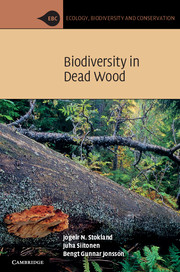Book contents
- Frontmatter
- Contents
- Preface
- 1 Introduction
- 2 Wood decomposition
- 3 The saproxylic food web
- 4 Other associations with dead woody material
- 5 Host-tree associations
- 6 Mortality factors and decay succession
- 7 Microhabitats
- 8 Tree size
- 9 The surrounding environment
- 10 Evolution of saproxylic organisms
- 11 Species diversity of saproxylic organisms
- 12 Natural forest dynamics
- 13 Dead wood and sustainable forest management
- 14 Population dynamics and evolutionary strategies
- 15 Threatened saproxylic species
- 16 Dead wood in agricultural and urban habitats
- 17 The value and future of saproxylic diversity
- References
- Index
17 - The value and future of saproxylic diversity
Published online by Cambridge University Press: 05 June 2012
- Frontmatter
- Contents
- Preface
- 1 Introduction
- 2 Wood decomposition
- 3 The saproxylic food web
- 4 Other associations with dead woody material
- 5 Host-tree associations
- 6 Mortality factors and decay succession
- 7 Microhabitats
- 8 Tree size
- 9 The surrounding environment
- 10 Evolution of saproxylic organisms
- 11 Species diversity of saproxylic organisms
- 12 Natural forest dynamics
- 13 Dead wood and sustainable forest management
- 14 Population dynamics and evolutionary strategies
- 15 Threatened saproxylic species
- 16 Dead wood in agricultural and urban habitats
- 17 The value and future of saproxylic diversity
- References
- Index
Summary
In this final chapter we address some issues that we consider essential for the future of dead wood and its biodiversity. Until now we have mainly focused on the biological aspects of dead wood and have only to a limited extent considered wider topics such as ecosystem functions, the future of forest biodiversity, and the need to disseminate information about the fascinating life in decaying wood.
Value of saproxylic diversity
We are convinced that the intrinsic value of the saproxylic species is a sufficient motivation for their protection. We can be fascinated by the peculiarity, strangeness and beauty of saproxylic species, and learn tremendously from the intricate interactions between them. But species living in dead wood are also more directly valuable, by providing products, ecological services and option values.
Ecological functions, services and resilience
The species that colonize and utilize dead trees provide a central ecosystem service, namely the decay of organic matter and the connected recycling of energy and nutrients. The decomposer community, mainly fungi but assisted by a multitude of invertebrates, performs this service at no cost, allowing the other living components of forest ecosystems to thrive. There is a growing awareness that the global loss of species threatens the provision of services such as decay and nutrient turnover. One might ask if the overwhelming variety of species living in wood is really necessary from this perspective. Maybe it would be enough that a few key species are present and that the vast majority of species are actually redundant. In any specific case there is probably no clear and simple answer, but a growing body of evidence suggests that a critical feature in ecosystems is the level of resilience (see, e.g., Rockstr ö m et al., 2009 ). It is highly unlikely that the exact number of ‘necessary’ species could be dei ned despite the fact that several species may perform the same function, rather than all of them having critical and unique functions.
- Type
- Chapter
- Information
- Biodiversity in Dead Wood , pp. 402 - 412Publisher: Cambridge University PressPrint publication year: 2012
- 3
- Cited by



